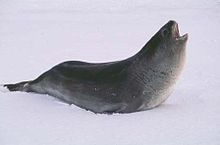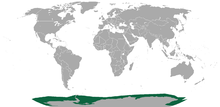- Ross seal
-
Ross seal 
Ross seal (Ommatophoca rossii) Conservation status Scientific classification Kingdom: Animalia Phylum: Chordata Class: Mammalia Order: Carnivora Superfamily: Pinnipedia Family: Phocidae Subfamily: Monachinae Tribe: Lobodontini Genus: Ommatophoca Species: O. rossii Binomial name Ommatophoca rossii
(Gray, 1844)
Ross Seal range The Ross seal (Ommatophoca rossii) is a true seal (family Phocidae) with a range confined entirely to the pack ice of Antarctica. It is the only species of the genus Ommatophoca. First described during James Clark Ross' British Antarctic Expedition in 1841, it is the smallest, least abundant and least well known of the Antarctic pinnipeds. Its distinctive features include disproportionately large eyes, whence its scientific name (Ommato- meaning "eye", and phoca meaning "seal"), and complex, trilling and siren-like vocalizations.
Contents
Taxonomy and evolution
The Ross seal shares a recent common ancestor with the other Antarctic seals, which are together known as the lobodontine seals. These include the crabeater seal (Lobodon carcinophaga), leopard seal (Hydrurga leptonyx) and Weddell seal (Leptonychotes weddelli).[2] These species, collectively belonging to the Lobodontini tribe of seals, share teeth adaptations, including lobes and cusps useful for straining smaller prey items out of the water column. The ancestral Lobodontini likely diverged from its sister clade, the Mirounga (elephant seals) in the late Miocene to early Pliocene, when they migrated southward and diversified rapidly in relative isolation around Antarctica.[2]
Description
Ross seals reach a length of about 1.68–2.09 m (5.5–6.9 ft) and weight of 129–216 kg (280–480 lb); females are slightly larger at 1.96–2.5 m (6.4–8.2 ft).[1] Pups are about 1 m and 16 kg at birth. The coat is colored dark-brown in the dorsal area and silvery-white beneath. At the onset of the Antarctic winter, the coat fades gradually to become light brown. At close range, the Ross seal can be easily identified by its large eyes, which are up to 7 cm in diameter.
The Ross seal is able to produce a variety of complex twittering and siren-like sounds that are performed on ice and underwater, where they carry for long distances.[3] The underwater siren sound can be composed of two harmonically unrelated superimposed tones that are pulsed with the same rhythm. Uniquely, the vocalizations, whether on ice or in water, are made with a closed mouth - emitting no air. The purpose of these sounds is unknown, though their distinctive nature and long range are likely to facilitate either encounters or avoidance of individuals.[3]
Range and population status
Although Weddell seals, crabeater seals and leopard seals are ubiquitous in Antarctic waters, the Ross seal is an uncommon and relatively unknown animal, considered to be the least common pack ice seal. It almost never leaves the Antarctic Ocean, with the very rare exception of stray animals found around sub-Antarctic islands, and uniquely, off the south coast of Australia. Nonetheless, its distribution is circumpolar, with individuals found in low densities - usually singly - in very thick pack ice in all regions of the continent.
The total Ross seal population is estimated at around 130,000 individuals, but there is great uncertainty in this estimate (reported 95% confidence intervals range from 20,000 to 227,000).[4] Thus, very little is known about trends in the population.
Interactions with humans have been limited. They have been collected historically by Antarctic expeditions and for scientific collections. Their range does not generally overlap with commercial fishing.
Feeding and reproductive behavior
The Ross seal feeds primarily on squid and fish, primarily Antarctic silverfish, in the pelagic zone.[5] Ross seals are presumed to be preyed upon by killer whales (Orcinus orca) and leopard seals, large predators that share their Antarctic habitat, though there are no documented observations of predation.
Females give birth to their young on the ice in November. Pups are nursed for only four weeks before weaning. Mating is thought to occur underwater shortly after the pup is weaned, but has never been observed. Ross seals mature sexually at approximately three years of age, and are though thought to live around 20 years in the wild.[5]
References and external links
- University of Michigan museum of zoology
- Seal conservation society webpage
- Fisheries Global Information System factsheet
References
- ^ a b Southwell, C. (2008). Ommatophoca rossii. In: IUCN 2008. IUCN Red List of Threatened Species. Downloaded on 28 January 2009.
- ^ a b Fyler, C.A.; Reeder, T.W.; Berta, A.; Antonelis, G.; Aguilar, A.; Androukaki (2005), "Historical biogeography and phylogeny of monachine seals (Pinnipedia: Phocidae) based on mitochondrial and nuclear DNA data", Journal of Biogeography 32: 1267–1279
- ^ a b Watkins, William A.; Carleton Ray, G. (1985), "In-air and underwater sounds of the Ross seal, Ommatophoca rossi", The Journal of the Acoustical Society of America 77 (4): 1598–1600, doi:10.1121/1.392003, http://link.aip.org/link/?JAS/77/1598/1, retrieved 2010-06-06
- ^ Southwell, C.J.; Paxton, C.G.M.; Borchers, D.L.; Boveng, P.L.; Nordøy, E.S.; Blix, A.S.; De La Mare, W.K. (2008), "Estimating population status under conditions of uncertainty: the Ross seal in East Antarctica", Antarctic Science 20 (2): 123–133
- ^ a b Skinner, J.D.; Klages, NTW (1994), "On some aspects of the biology of the Ross seal Ommatophoca rossii from King Haakon VII Sea, Antarctica", Polar Biology 7 (467): 472
Categories:- IUCN Red List least concern species
- True seals
- Mammals of South Australia
- Vulnerable fauna of Australia
- Monotypic mammal genera
- Megafauna
- Animals described in 1844
Wikimedia Foundation. 2010.

